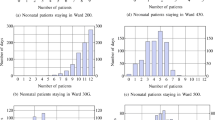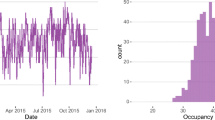Abstract
We analyze the dynamics of nosocomial infections in intensive care units (ICUs) by using a Markov chain model. Since population size in the ICU is small, in contrast to previous studies, we concentrate on the analytical solution rather than using simulation. We investigate how changes in the system parameters affect to some important behavioral indicators of the spread of the pathogen. We also present an exact measure of the number of secondary cases of infection produced by one colonized patient.





Similar content being viewed by others
References
Andersson H, Britton T (2000) Stochastic epidemic models and their statistical analysis. Lecture notes in biostatistics, vol 151. Springer, New York
Allen LJS (2008) An introduction to stochastic epidemic models. In: Lecture notes in mathematics, vol 1945. Springer, Berlin, pp 81–130
Allen LJS, van den Driessche P (2013) Relations between deterministic and stochastic thresholds for disease extinction in continuous- and discrete-time infectious disease models. Math Biosci 243:99–108
Artalejo JR, Economou A, Lopez-Herrero MJ (2010) On the number of recovered individuals in the SIS and SIR stochastic epidemic models. Math Biosci 228:45–55
Artalejo JR, Lopez-Herrero MJ (2010) Quasi-stationarity and ratio of expectations: a comparative study. J Theor Biol 266:264–274
Artalejo JR, Economou A, Lopez-Herrero MJ (2012) Stochastic epidemic models revisited: analysis of some continuous performance measures. J Biol Dyn 6:189–211
Artalejo JR, Lopez-Herrero MJ (2013) On the exact measure of disease spread in stochastic epidemic models. Bull Math Biol 75:1031–1050
Artalejo JR, Economou A, Lopez-Herrero MJ (2013) Stochastic epidemic models with random environment: quasi-stationarity, extinction and final size. J Math Biol 67:799–831
Bacaër N, Gomes MGM (2009) On the final size of epidemics with seasonality. Bull Math Biol 71:1954–1966
Chamchod F, Ruan S (2012) Modeling the spread of methicillin-resistant staphylococcus aureus in nursing homes for elderly. PloS One 7:e29757
Ciarlet PG (1989) Introduction to numerical linear algebra and optimization. Cambridge University Press, Cambridge
Cooper BS, Medley GF, Scott GM (1999) Preliminary analysis of the transmission dynamics of nosocomial infections: stochastic and management effects. J Hosp Infect 43:131–147
Daley DJ, Gani J (1999) Epidemic modelling: an introduction, cambridge studies in mathematical biology 15. Cambridge University Press, Cambridge
Diekmann O, Heesterbeek JAP (2000) Mathematical epidemiology of infectious diseases: model building, analysis and interpretation. Wiley series in mathematical and computational biology. Wiley, Chichester
Diekmann O, Heesterbeek H, Britton T (2013) Mathematical tools for understnading infectious disease dynamics. Princeton University Press, Princeton
Hotta LK (2010) Bayesian melding estimation of a stochastic SEIR model. Math Popul Stud 17:101–111
Keeling MJ, Rohani P (2008) Modeling infectious diseases in humans and animals. Princeton University Press, Princeton
Keeling MJ, Ross JV (2008) On methods for studying stochastic disease dynamics. J R Soc Interface 5:171–181
Kondakci S, Dincer C (2011) Internet epidemiology: healthy, susceptible, infected, quarantined, and recovered. Secur Commun Netw 4:216–238
Kouokam E, Auger P, Hassan H, Tchuente M (2008) Effect of the number of patches in a multi-path SIRS model with fast migration of the basic reproduction rate. Acta Biotheor 56:75–86
Li J, Blakeley D, Smith? RJ (2011) The failure of R0. Comput Math Methods Med 527610:17
McBryde ES, Pettitt AN, McElwain DLS (2007) A stochastic mathematical model of methicillin resistant Staphylococcus aureus transmission in an intensive care unit: predicting the impact of interventions. J Theor Biol 245:470–481
Pinto A, Aguiar M, Martins J, Stollenwerk N (2010) Dynamics of epidemiological models. Acta Biotheor 58:381–389
Roberts MG (2007) The pluses and minuses of R0. J R Soc Interface 4:946–961
Ross JV (2011) Invasion of infectious diseases in finite homogeneous populations. J Theor Biol 289:83–89
Stone P, Wilkinson-Herbots H, Isham V (2008) A stochastic model for head lice infections. J Math Biol 56:743–763
Acknowledgements
The author is grateful to the referees for their constructive comments which were certainly helpful to improve the paper. This work was supported by the Government of Spain (Department of Science and Innovation) and the European Commission through project MTM 2011-23864.
Author information
Authors and Affiliations
Corresponding author
Rights and permissions
About this article
Cite this article
Artalejo, J.R. On the Markovian Approach for Modeling the Dynamics of Nosocomial Infections. Acta Biotheor 62, 15–34 (2014). https://doi.org/10.1007/s10441-013-9204-6
Received:
Accepted:
Published:
Issue Date:
DOI: https://doi.org/10.1007/s10441-013-9204-6




